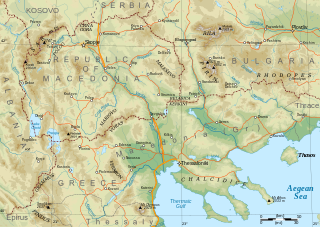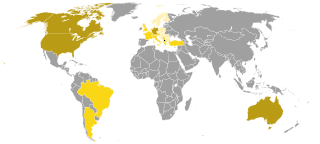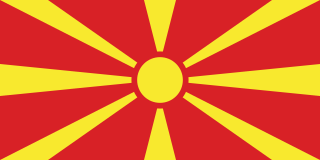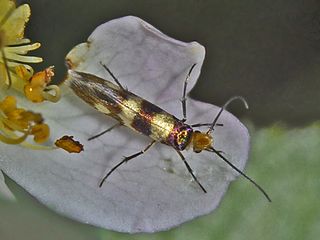
The Balkans, also known as the Balkan Peninsula, is a geographical area in southeastern Europe with various geographical and historical definitions. The region takes its name from the Balkan Mountains that stretch throughout the whole of Bulgaria. The Balkan Peninsula is bordered by the Adriatic Sea in the northwest, the Ionian Sea in the southwest, the Aegean Sea in the south, the Turkish Straits in the east, and the Black Sea in the northeast. The northern border of the peninsula is variously defined. The highest point of the Balkans is Mount Musala, 2,925 metres (9,596 ft), in the Rila mountain range, Bulgaria.

Macedonian is an Eastern South Slavic language. It is part of the Indo-European language family, and is one of the Slavic languages, which are part of a larger Balto-Slavic branch. Spoken as a first language by around two million people, it serves as the official language of North Macedonia. Most speakers can be found in the country and its diaspora, with a smaller number of speakers throughout the transnational region of Macedonia. Macedonian is also a recognized minority language in parts of Albania, Bosnia and Herzegovina, Romania, and Serbia and it is spoken by emigrant communities predominantly in Australia, Canada and the United States.

Macedonia is a geographical and historical region of the Balkan Peninsula in Southeast Europe. Its boundaries have changed considerably over time; however, it came to be defined as the modern geographical region by the mid 19th century. Today the region is considered to include parts of six Balkan countries: larger parts in Greece, North Macedonia, and Bulgaria, and smaller parts in Albania, Serbia, and Kosovo. It covers approximately 67,000 square kilometres (25,869 sq mi) and has a population of 4.76 million.
The history of North Macedonia encompasses the history of the territory of the modern state of North Macedonia.

Pomaks are Bulgarian-speaking Muslims inhabiting northwestern Turkey, Bulgaria and northeastern Greece. The c. 220,000 strong ethno-confessional minority in Bulgaria is recognized officially as Bulgarian Muslims by the government. The term has also been used as a wider designation, including also the Slavic Muslim populations of North Macedonia and Albania.

Macedonians are a nation and a South Slavic ethnic group native to the region of Macedonia in Southeast Europe. They speak Macedonian, a South Slavic language. The large majority of Macedonians identify as Eastern Orthodox Christians, who speak a South Slavic language, and share a cultural and historical "Orthodox Byzantine–Slavic heritage" with their neighbours. About two-thirds of all ethnic Macedonians live in North Macedonia and there are also communities in a number of other countries.

The Treaty of Neuilly-sur-Seine required Bulgaria to cede various territories, after Bulgaria had been one of the Central Powers defeated in World War I. The treaty was signed on 27 November 1919 at Neuilly-sur-Seine, France.
Southeast Europe or Southeastern Europe (SEE) is a geographical subregion of Europe, consisting primarily of the Balkans, as well as adjacent regions and archipelagos. Sovereign states and territories that are included in the region are Albania, Bosnia and Herzegovina, Bulgaria, Croatia, Cyprus, Greece, Kosovo, Montenegro, North Macedonia, Romania, Serbia, and Turkey. Sometimes, Moldova and Slovenia are also included. The largest city of the region is Istanbul, followed by Bucharest, Sofia, Belgrade, and Athens.

The accession of North Macedonia to the European Union has been on the current agenda for future enlargement of the EU since 2005, when it became a candidate for accession. The Republic of Macedonia submitted its membership application in 2004, thirteen years after its independence from Yugoslavia. It is one of eight current EU candidate countries, together with Albania, Bosnia and Herzegovina, Moldova, Montenegro, Serbia, Turkey and Ukraine.

North Macedonia, officially the Republic of North Macedonia, is a country in Southeast Europe. It gained independence in 1991 as one of the successor states of Yugoslavia. It is a landlocked country bordering Kosovo to the northwest, Serbia to the north, Bulgaria to the east, Greece to the south, and Albania to the west. It constitutes approximately the northern third of the larger geographical region of Macedonia. Skopje, the capital and largest city, is home to a quarter of the country's 1.83 million people. The majority of the residents are ethnic Macedonians, a South Slavic people. Albanians form a significant minority at around 25%, followed by Turks, Romani, Serbs, Bosniaks, Aromanians and a few other minorities.

Micropterix allionella is a moth of the family Micropterigidae. It was described by Johan Christian Fabricius in 1794.
Micropterix erctella is a species of moth belonging to the family Micropterigidae which was described by Walsingham, Lord Thomas de Grey, in 1919. It is endemic to Sicily.
Micropterix fenestrellensis is a species of moth belonging to the family Micropterigidae. It was described by John Heath and T. Kaltenbach in 1984. It is known from Italy.
Micropterix myrtetella is a species of moth belonging to the family Micropterigidae. It was described by Philipp Christoph Zeller in 1850. It is found in Italy, Austria, the Czech Republic, Slovakia, Hungary, Croatia, Serbia and Montenegro, Albania, North Macedonia, Bulgaria, Greece, Romania and Ukraine.
Micropterix kardamylensis is a species of moth belonging to the family Micropterigidae. It was described by Hans Rebel in 1903. It is found in the southern Peloponnese in Greece. There are also records from Bosnia and Herzegovina, Montenegro, North Macedonia, Albania and Bulgaria, but these might be Micropterix tunbergella instead.

Micropterix schaefferi is a species of moth belonging to the family Micropterigidae that was described by John Heath in 1975. Male Micropterix schaefferi have a wingspan of 3.8–5.1 millimetres (0.15–0.20 in), while females have a wingspan of 4.7–5.8 millimetres (0.19–0.23 in). It is known from France, Corsica, Italy, Belgium, the Netherlands, Germany, Switzerland, Austria, Hungary, Czech Republic, Bulgaria, Denmark, and Poland. Moths in this species inhabit woodlands with many beech and coniferous trees, and are also known to inhabit moist ravine forests and dry pine forests.
Micropterix rablensis is a species of moth belonging to the family Micropterigidae, which was described by Philipp Christoph Zeller in 1868. It is probably restricted to Carinthia in Austria and to the adjacent areas of Styria in Austria and Italy and potentially of Slovenia. Its Croatian, Romanian and French existence is doubtful.
Micropterix trinacriella is a species of moth belonging to the family Micropterigidae that was described by Michael A. Kurz, Hans Christof Zeller-Lukashort and Marion E. Kurz in 1997. It is only known from the area near the northern shore of Sicily, as well as in the surrounding of Mount Etna.
Micropterix uxoria is a species of moth belonging to the family Micropterigidae. It was described by Walsingham in 1919 and is endemic to Sicily.

The Bulgarian occupation of Serbia of WW1 started in Autumn 1915 following the invasion of Serbia by the combined armies of Germany, Austria-Hungary and Bulgaria. After Serbia's defeat and the retreat of its forces across Albania, the country was divided into Bulgarian and Austro-Hungarian occupation zones.









